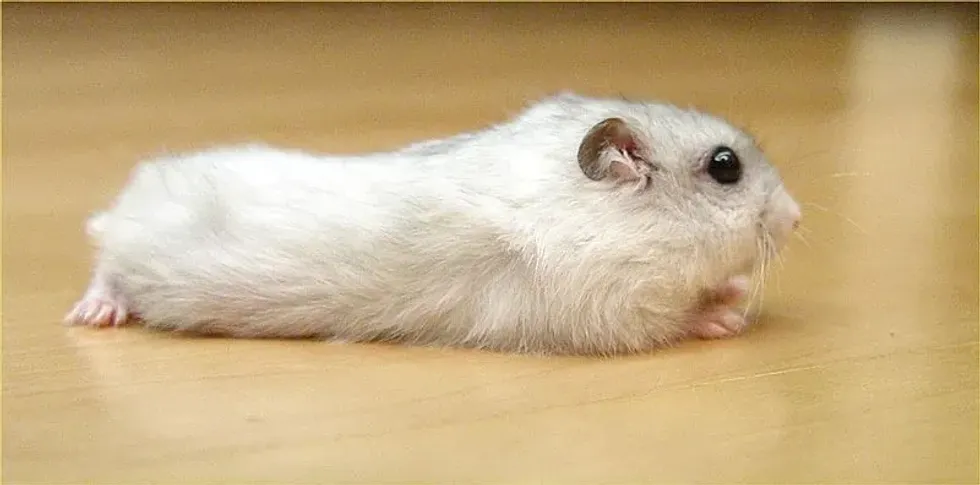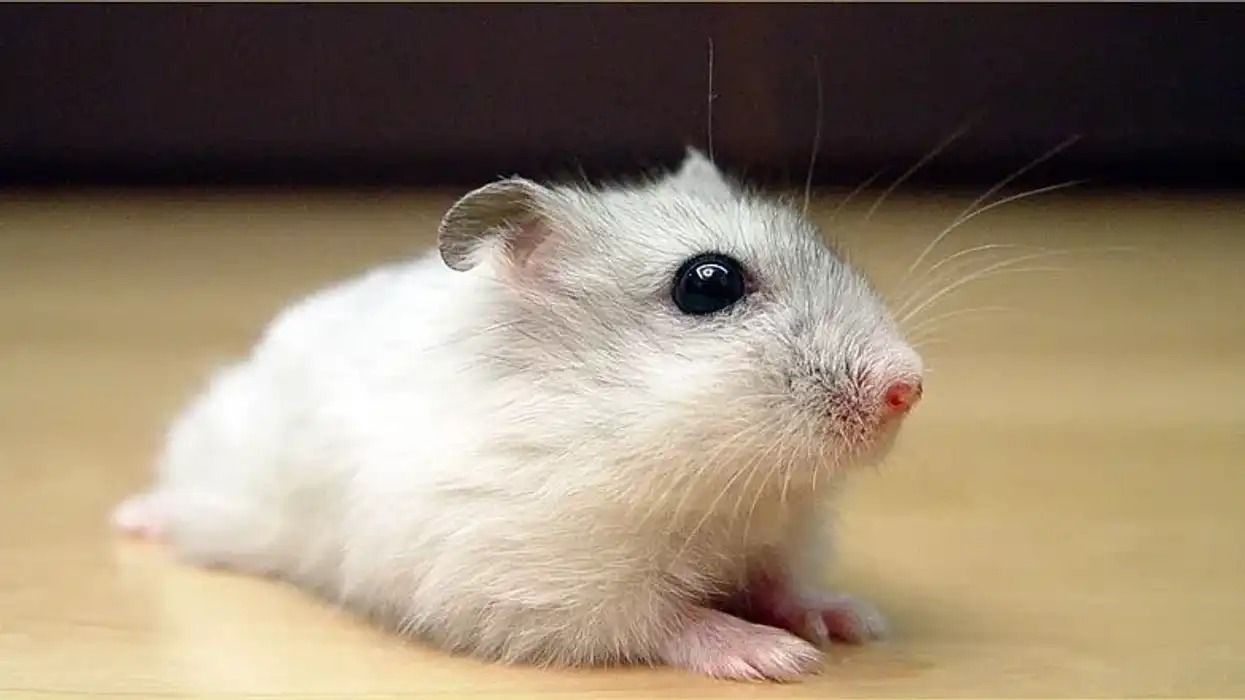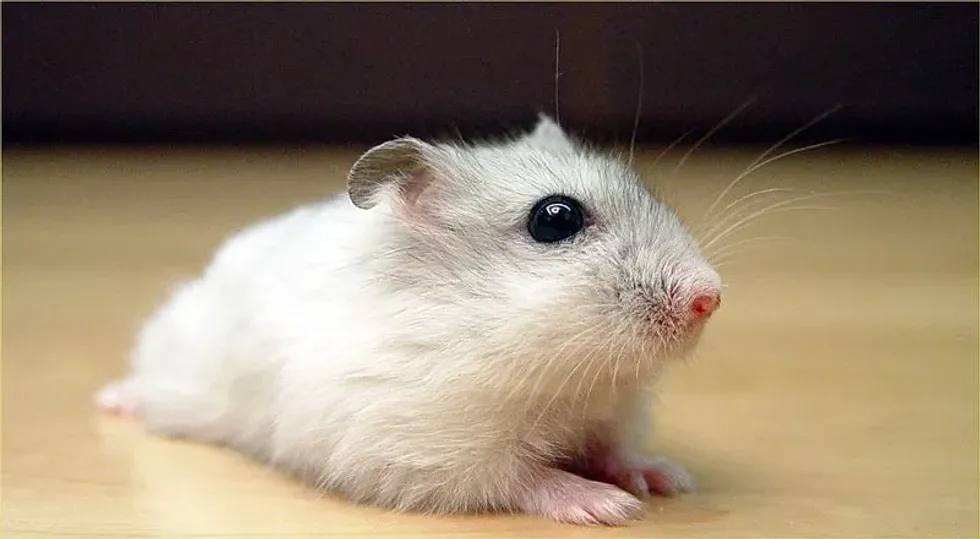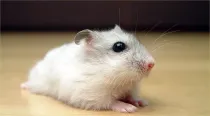Fun Winter White Dwarf Hamster Facts For Kids

Are you thinking of keeping a hamster as a pet? Then, why not read up about the winter white dwarf hamster and see if you would like to keep this little ball of fur as your companion?
The winter white dwarf hamster (Phodopus sungorus) is one of the four pet species of dwarf hamsters. The other three of the lot are the Chinese dwarf hamster, Roborovski dwarf hamster, and Campbell's dwarf hamster. In terms of size, the Roborovski hamster is the smallest among them all.
Dwarf hamsters are popular pets across the world. These small mammals have stout bodies, stubby legs, a short tail, and rarely exceed 3 in (8 cm) in length.
Dwarf hamster species are common throughout Asia and Europe, with their range extending up to Pakistan, Syria, China, Mongolia, and Siberia. While the dwarf hamster's natural habitat varies with the species, the animals can be found in diverse environments that include deserts, scrublands, forests, and mountainous regions.
Consequently, the diet of the hamster species depends on the particular habitat it lives in. In the wild, dwarf hamsters are omnivores and, depending on the species, may be active at night or during the day.
The winter white dwarf hamster is known by several other names such as the Siberian dwarf hamster, Siberian hamster, Russian hamster, striped dwarf hamster, Djungarian hamster, and Russian dwarf hamster. The wild members of this particular dwarf hamster species originate from Siberia and Kazakhstan.
Yet, it is one of the most popular hamster breeds in North America, Europe, and Asia.
Even though they come in several color varieties, a distinctive feature of the species is that their fur turns completely white in winter, and hence the name. In addition, the hamsters have furry feet and a dark gray, thick dorsal stripe running along the back of the body.
Read on to discover many more interesting facts about these cute little animals, including winter white dwarf hamster care tips! In case you are curious about other small mammals, do check out pouched rat and hazel dormouse facts.
Winter White Dwarf Hamster Interesting Facts
What type of animal is a winter white dwarf hamster?
The winter white dwarf hamster or Russian hamster is a species of pet dwarf hamster belonging to the rodent family Cricetidae. The gray dwarf hamster is another dwarf hamster species.
What class of animal does a winter white dwarf hamster belong to?
Winter white dwarf hamsters belong to the class of mammals (class Mammalia).
How many winter white dwarf hamsters are there in the world?
The global population size of the winter white dwarf hamster or Russian hamster is not known. Since they are popular as pets, it can be said that their numbers are in abundance.
Where does a winter white dwarf hamster live?
Winter white dwarf hamsters originate in Asia. In the wild, these hamsters are found in Kazakhstan, Siberia, Mongolia, and Manchuria. However, they are common pets all throughout North America and Europe as well.
What is a winter white dwarf hamster's habitat?
In the wild, the Russian dwarf hamsters commonly inhabit alfalfa or wheat fields, steppes, and semi-deserts. As pets, the Russian dwarf hamster can live in a cage of suitable size.
Housing a pet Russian dwarf hamster is not much of a trouble. Despite their small size, it is best to buy a sufficiently large cage or tank.
The cage or tank should be a minimum of 24 in (61 cm) long and 12 in (30.5 cm) wide. A 20 gal (76 l) tank would also be perfect.
In addition, the cage or tank should be secure and have enough ventilation.
The bottom of the cage should also have soft bedding, 2-3 in (5-7.6 cm) thick, and made of shredded paper, wood shavings, or any commercial bedding material. In case you are using wood shavings, avoid pinewood or cedar since these may harm your pet.
Since pet dwarf hamsters are quite active, providing exercise wheels, tubes, and climbing structures is a great way to keep them busy. You can also place a nesting box or house inside the cage to let your pet sleep and hide.
Who do winter white dwarf hamsters live with?
As long as winter white dwarf hamsters are kept in a group comprising members of the same species, they are good to go. In other words, a pet winter white dwarf hamster will live peacefully with another winter white dwarf hamster but not with, say, a Campbell's dwarf hamster.
Also, if you are keeping them as pets and want to avoid unwanted litter, it is best to keep opposite-sex pairs together.
Besides, young winter white dwarf hamster babies are known to be aggressive towards each other, and so are the females towards the males. That said, in terms of the winter white dwarf hamster temperament, the animals are pretty easy to tame.
How long does a winter white dwarf hamster live?
The winter white dwarf hamster lifespan in captivity can range between one to three years. In the wild, the lifespan of a hamster is hardly a year.
How do they reproduce?
Russian hamsters have a very high reproduction rate, a survival strategy intended to produce a large number of offspring in a very short time. Hence, it is best to keep these pet hamsters as groups of same-sex individuals if you do not want them to reproduce.
Russian hamsters reach breeding maturity at a young age of four to five weeks, an important reason why newborn hamsters should be separated as soon as they are weaned. The female hamsters are fertile during their estrus cycle, during which they may get pregnant within the course of 24 hours.
An estrus cycle lasts for about four days. The gestation period is usually 18 days but may differ depending on the specific breed.
The size of the litter varies but typically has around six pups. The pups are born blind and naked and take about two weeks to develop the fur coat. Their eyes do not open until they are ready to be independent.
Winter white dwarf hamsters are known to be very aggressive during breeding time. In fact, it is very common for female hamsters to attack the males to protect the cubs.
What is their conservation status?
As per the International Union for Conservation of Nature (IUCN) Red List of Threatened Species, the winter white dwarf hamster is a species of Least Concern.
Winter White Dwarf Hamster Fun Facts
What do winter white dwarf hamsters look like?
Winter white dwarf hamsters have a roundish, oval-like body with furry feet, a Roman nose, and a soft, smooth fur coat. They are usually grayish to dark brown with a prominent black dorsal stripe running along from the head to tail.
The belly, tail, throat, and limbs are white. The ears are grayish with a tint of pink.
This typical coloration is observed in summer and the hamsters change their fur color in winter. The winter coat is denser and lighter, often changing to pearly white, especially in the wild. The color transition may be less prominent in the case of pets or those in captivity.
Other color variations include sapphire pearl, sapphire, colored pearl, and marbled. Hybrids with Campbell's dwarf hamsters may give rise to colors like umbrous, merle, cream, brown, camel, yellow blue fawn, argente, and mandarin.

How cute are they?
Given their snowy white fur and their mini size, these dwarf hamsters are pretty sweet.
How do they communicate?
Dwarf hamsters hardly make any vocal sounds, and even if they do, it is not audible to human ears. Besides, they use scents to communicate with each other. Scent glands located in different parts of the hamsters' body release chemical substances that may aid in marking territory or establishing status.
Besides, these hamsters may use various body gestures to convey aggression, fear, and contentment. In addition, these dwarf hamsters may take well to people holding them unless they are uncomfortable. Hence, when held, these pets should be handled gently.
How big is a winter white dwarf hamster?
Winter white dwarf hamsters usually grow to a length of about 3-4 in (7.6-10 cm), the same as that of a Chinese dwarf hamster. Both are approximately half the size of the Syrian hamsters.
How fast can a winter white dwarf hamster run?
An estimate of the running speed of the winter white dwarf hamsters is not available. However, these dwarf hamsters love to run, and if you have them as pets, you will see that they enjoy running on hamster wheels.
Hence, you must ensure that the pet hamster cage you buy has a wheel or enough room to let the animal run around.
How much does a winter white dwarf hamster weigh?
While male winter white dwarf hamsters weigh between 0.7-1.6 oz (19-45 g), the weight of females can range between 0.7-1.3 oz (19-36 g). The pet hamsters tend to be heavier.
What are the male and female names of the species?
A male hamster is called a buck, and a female hamster is called a doe.
What would you call a baby winter white dwarf hamster?
A baby hamster is called a pup.
What do they eat?
The winter white dwarf hamster diet consists of fruits, vegetables, nuts, seeds, and insects. Food pellets also make for perfect treats. If you have a pet winter white dwarf hamster, you can supplement ready-made food mix with other treats like fresh vegetables, fruits, insects, pasta, and whole-grain cereal.
Are they dangerous?
Russian hamsters are anything but dangerous. As a pet, they are pretty easy to tame.
Would they make a good pet?
Russian hamsters make charming and rewarding pets. They are placid, easy to tame, cuddly, and will enjoy your touch once comfortable. However, they tend to nip when annoyed and hence should be kept away from younger children. The Syrian hamsters are a more suitable choice as a pet for younger children.
Did you know...
Peter Simon Pallas first described the Russian hamster in 1773. However, he had named the organism Mouse songarus, classifying it as a mouse. In 1912, Ned Hollister shifted the hamster to its current genus Phodopus.
The specific epithet of the Russian hamster (sungorus) is derived from the geographic region of Dzungaria in northwest China.
The winter white dwarf hamster's main predator is the weasel.
The change in day length between summer and winter drives the change in the coat color of Russian hamsters. In addition, the pigmentation of the fur is due to color genetics and the hormone prolactin.
The change to white fur in winter is a survival adaptation that helps the wild hamsters to conceal themselves in the snow and evade predators in snow-covered regions. In addition, the wild dwarf hamsters dig tunnels in the ground leading to underground burrows where the animals can hide from predators, feed, sleep, and protect their young.
Most of the burrows have six entrances.
In winter, the burrows are lined with animal wool or fur, and all but only one entrance is kept open. The burrows have moss lining in summer.
While normal Russian hamsters have black eyes, the eye color is red in the albinos.
While hamsters are generally tough pets, they may occasionally suffer from common health problems. Typical health issues include respiratory infections, skin issues (mites), abscesses, wet tails (diarrhea), and injuries from fights, falls, or sharp objects.
What other hamsters do winter white dwarf hamsters get on well with?
The Russian hamsters do not really get on well with other hamster breeds. However, you can keep a Russian hamster with others of its own species but do watch out for bullying and fighting. If you are a beginner, it is best that you keep only one pet hamster until you are acquainted with its ways.
What is a winter white dwarf hamster's favorite food?
If you own a Russian hamster, you can give it a ready-made food mix supplemented with treats like fresh fruits, vegetables, seeds, pasta, or whole-grain cereals.
Here at Kidadl, we have carefully created lots of interesting family-friendly animal facts for everyone to discover! Learn more about some other mammals including Roborovski hamsters facts and Douglas squirrel facts pages.
You can even occupy yourself at home by coloring in one of our free printable angry porcupine coloring pages.
Boths images by Jpbarrass.
We Want Your Photos!
More for You
See All
Bachelor of Science specializing in Microbiology

Oluwatosin MichaelBachelor of Science specializing in Microbiology
With a Bachelor's in Microbiology from the Federal University of Agriculture, Abeokuta, Ogun State, Oluwatosin has honed his skills as an SEO content writer, editor, and growth manager. He has written articles, conducted extensive research, and optimized content for search engines. His expertise extends to leading link-building efforts and revising onboarding strategies.
Disclaimer
1) Kidadl is independent and to make our service free to you the reader we are supported by advertising. We hope you love our recommendations for products and services! What we suggest is selected independently by the Kidadl team. If you purchase using the Buy Now button we may earn a small commission. This does not influence our choices. Prices are correct and items are available at the time the article was published but we cannot guarantee that on the time of reading. Please note that Kidadl is a participant in the Amazon Services LLC Associates Program, an affiliate advertising program designed to provide a means for sites to earn advertising fees by advertising and linking to Amazon. We also link to other websites, but are not responsible for their content.
2) At Kidadl, we strive to recommend the very best activities and events. We will always aim to give you accurate information at the date of publication - however, information does change, so it’s important you do your own research, double-check and make the decision that is right for your family. We recognise that not all activities and ideas are appropriate for all children and families or in all circumstances. Our recommended activities are based on age but these are a guide. We recommend that these ideas are used as inspiration, that ideas are undertaken with appropriate adult supervision, and that each adult uses their own discretion and knowledge of their children to consider the safety and suitability. Kidadl cannot accept liability for the execution of these ideas, and parental supervision is advised at all times, as safety is paramount. Anyone using the information provided by Kidadl does so at their own risk and we can not accept liability if things go wrong.
3) Because we are an educational resource, we have quotes and facts about a range of historical and modern figures. We do not endorse the actions of or rhetoric of all the people included in these collections, but we think they are important for growing minds to learn about under the guidance of parents or guardians.







